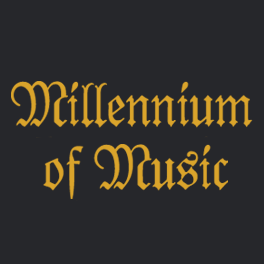Organization Member
Contact Information
https://www.millenniumofmusic.com
Silver Spring, Maryland
Type of Organization
Recording or Media CompanyAbout
HISTORY
Millennium of Music was born in 1975 at public radio station WJCT in Jacksonville, Florida, as a Sunday morning program called Musica Antiqua.
There had been an attempt or two to create pre-Baroque programming from what was available (which was surprisingly extensive even before the early music boom of the 1980s), but this kind of specialty sound was rare enough to be a great novelty. Public radio at that time was still a place for inventive and risky undertakings. The program director, Landon Walker (who still performs and produces concerts in Jacksonville), took a chance on what was then a radical idea; the program still survives in a local form at WJCT.
After some months, and a return to my home town of Washington, D.C., the next incarnation of the program was a late Sunday spot on the big public radio station for which I had come to work in 1978, WETA. At that time, Program Director Martin Goldsmith (who went on to host National Public Radio’s daily classical music offering Performance Today before becoming the program director for "XM Classics" on XM Satellite Radio) suggested that the idea of a really early music program, with much emphasis on Gregorian chant, would be appropriate for Easter. We refined around the edges and the program began as a regular part of the schedule on Easter Sunday in 1980.
The next visionary to touch the program was Mary Beth Kirchner, a producer brought on board to help create national programming, who believed in the inevitability of taking the program to a wider audience. After an initial launch to 70 stations in 1990, we are now heard on about 150 stations around the country through our syndicator, WCLV/Seaways Productions. Millennium of Music is now produced by RADman Productions and can also be heard on XM Satellite Radio.
– Robert Aubry Davis
Program Background
Who can say how an interest begins? Like those people who dress up as medieval warriors and princesses, I whimsically suggest it is all an argument for reincarnation.
Perhaps the note was struck with Christmas, where even in the ‘50s a strain of music before 1800 was heard here and there. I surely remember the weekend morning radio program dear Bob Davis hosted on WGMS. It was baroque music when we were just having a second wave of rediscovery: My bedside clock radio, so important a way in the darkness of night to contact the revolutionaries in the vast cultural conspiracy (Rock ‘n’ Roll, the ultimate sedition!), became a sunny window into another era entirely on those mornings.
Parents I considered hopelessly oppressive freely allowed me to venture downtown to attend the amazing presentations of the Washington Performing Arts Society. I often told Patrick Hayes of the impact that seeing “Daniel and the Lions Den” or the Prague Madrigal Singers had on my heart (and soul). At the Library of Congress, I became a regular attendee of Alfred Deller’s occasional appearances, eventually hanging around backstage. “Who was the greatest of all these composers from before?”
“Josquin Desprez,” he told me. “You’ll never be sorry for investing time with him,” and I never have.
The endless stretch of time from that moment to my first radio job (ok, only seven years—but as we all know, those years from 18 to 25 are the times we measure in dog years) led to finally joining a public radio station in 1975. At WJCT in Jacksonville, Florida, an unlikely program called “Musica Antiqua” began, and even though I did not host it for more than six months, it continued on air there for 25 years.
That was the name I first brought before the then-music director of WETA, Martin Goldsmith, in 1978. There were two programs he already had going then: his own “Tudors and Stewarts,” and NPR’s “Cathedral, Courts, and Countryside.” So, the music was in the air, as it were. The first special was ninety minutes allowed at 11:30 p.m. during Easter evening before sign off. I chose mostly chant for the season, since that was the most neglected form of early music then broadcast (although that which received the highest record sales!).
Occasional specials followed, and with Easter 1980, a regular program began. Since an ensemble already existed in town called Musica Antiqua, their director informed me early on I needed another name. That process gave birth to the summation of what the program is and was: “The sources and mainstreams of European music for the thousand years before the birth of Bach: a Millennium of Music.”
THE TOP 5 SHOWS IN MoM’S HISTORY:
1). CHANT—While the program had often used performances by the monks of Santo Domingo de Silos, the packaging put them (and chant in general) on the map. My only Platinum Disc then, or ever.
2). SONGS OF THE SIBYLS—Reconstructions of the predictions of the ancient mystical women who advised Caesars and poets, this pre-Christian expression kept alive in Christianity’s early years was hair-raisingly reconstructed by the Hesperion XX ensemble—popular enough for the ensemble to produce three sequels..
3). ANGEL’S VISIT—Norwegian feminist icon Anne-Lise Berntsen reconstructing late medieval and renaissance Nordic folksong in an ancient church with a contemporary organist-composer…as unlikely, and fabulous, as it sounds.
4). TOP 10 EARLY MUSIC RECORDINGS—From 1986 until 2001, Fr. Jerome Weber of Fanfare and Goldberg magazines would chose the best discs of the year, from chant to early baroque—record companies noted a jump in sales from 10 to 15% overnight.
5). SERVICES FOM A DALMATIAN CATHEDRAL—The 2002 Utrecht Festival featured a series of performances from ancient Croatia that were heart-rending and soul-expanding—in this ancient crossroads of empire, everything from east and west was poured into a musical mosaic that truly sounds like nothing else.
– An article by Robert Aubry Davis printed in the WETA magazine, Washington, D.C.


